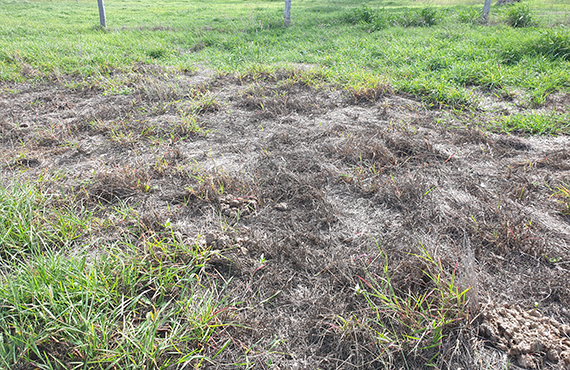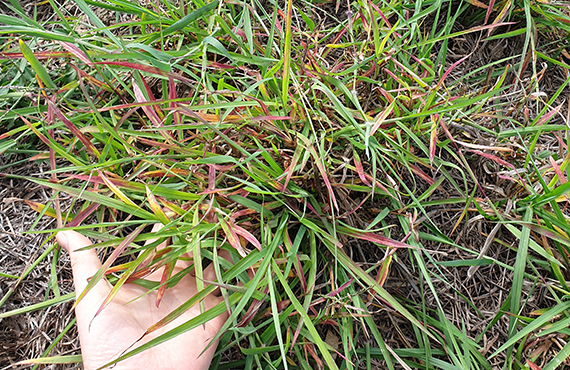
Pasture dieback
Updated: September 2024
 Read the Pasture Dieback Identification Guide
Read the Pasture Dieback Identification Guide
About pasture dieback
Pasture dieback is a condition that kills sown and native summer growing grass pastures. It starts as small patches and can spread to affect large areas. The grasses die reducing feed available for livestock. Often groundcover in these areas is low allowing broadleaf weeds to colonise. Pasture dieback is not limited by landscape or soil type. Livestock avoid grazing affected areas (Figure 1).

The current outbreak in Queensland commenced summer 2014-15. It has now spread across Queensland in coastal and inland regions from the far north Queensland to New South Wales (NSW). Pasture dieback was confirmed on the NSW North Coast in autumn 2020. Over the last four years it has spread south to the Coffs Harbour region and west to Tabulam region. Dieback was confirmed in inland NSW in autumn 2024 in the Boggabilla region (Figure 2).


What to look for
Symptoms are most evident when grasses are actively growing during spring, summer and autumn, especially following significant rainfall. The stages of symptom progression of pasture dieback include:
- Yellowing, reddening and purpling of leaves. Discolouration can vary between species. It starts with the oldest leaves and typically begins at the leaf tip and moves along the leaf blade towards the stem (Figure 3).
- Affected plants become stunted and unthrifty. These plants have fewer leaves and tillers, smaller seed heads and a smaller root system. Starts as small patches which grow and merge to affect large areas. The size of the affected area typically increases rapidly following significant rainfall in spring-autumn.
- Eventually the affected plants die.
- Patches where grasses have died are colonised by broadleaf weeds and legumes.
Many of the dieback symptoms can be caused by a range of other factors. These include but are not limited to: mineral deficiency, moisture stress, cold temperatures, herbicide damage, water logging and nematodes. It is important to eliminate these before assuming dieback. However a combination of symptoms, including a rapid increase of the affected area following significant rainfall are good indicators of pasture dieback. More information on symptoms can be found in the pasture dieback identification guide.


Species affected
Pasture dieback affects summer growing grasses. All of the commonly sown summer growing grasses are susceptible as well as a number of native and naturalised grasses. It has not been reported in temperate grasses.
Species known to be affected include:
- Angletongrass/bluegrass (Dicanthium aristatum)
- Bahia Grass (Paspalum notatum)
- Black spear-grass (Heteropogon contortus)
- Bambatsi panic (Panicum coloratum)
- Buffel grass (Cenchrus ciliaris)
- Carpet grass (Axonopus compressus)
- Couch (Cynodon dactylon)
- Creeping bluegrass (Bothriochloa insculpta)
- Digit grass (Digitaria eriantha)
- Forest bluegrass (Bothriochloa bladhii ssp. glabra)
- Gatton and green panic (Panicum maximum)
- Golden beard grass (Chrysopogon fallax)
- Kikuyu (Pennisetum clandestinum)
- Para grass (Brachiaria mutica syn. Urochloa mutica)
- Paspalum (Paspalum dilatatum, P. mandiocanum (syn. P. wettsteinii), P. urvillei and P. plicatulum)
- Purple pigeon grass (Setaria incrassata)
- Rhodes grass (Chloris gayana)
- Sabi grass (Urochloa mosambicensis)
- Setaria (Setaria sphacelata)
- Signal grass (Brachiaria decumbens syn. Urochloa decumbens)
There are potentially more grass species that are susceptible.

Cause
Pasture dieback is a complex condition involving pasture mealybug (Heliococcus summervillei). Pasture mealybugs are small sap sucking insects that feed on plants. The adult females are easiest to see with the naked eye (Figure 4). They are white or pink and up to 5 mm long. Juveniles can be 0.2 mm long. It is the juveniles feeding that causes leaf discolouration. Pasture mealybugs are mainly dispersed by wind.
Mealybug population numbers peak in late summer-autumn. During these times they can be found on leaves of symptomatic grasses, the soil surface and among the plant roots. In high rainfall warmer environments, such as the NSW North Coast, pasture mealybugs can be found year-round with careful inspection.
During cool or dry periods, mealybugs retreat below ground or under objects such as logs, cow pats and thatch. They can survive on grass roots and deep in the soil profile, emerging again to reinfest plant leaves when conditions become more favourable and susceptible grasses are actively growing.
More information on pasture mealybug can be found in the factsheet.


Can I prevent dieback?
There are currently no options to prevent pasture dieback from affecting susceptible pastures. Its prevalence in a pasture and the severity to which a pasture is affected is influenced by seasonal conditions and management. Actively growing pastures containing highly susceptible grasses and have high biomass are most at risk of being severely affected. A pasture with less susceptible grasses, good legume content and has been grazed is less likely to be impacted.

Managing pasture dieback affected land
A number of strategies have been developed to manage pasture dieback in Queensland. Recommendations have also been developed for the NSW North Coast (Table 1). These include managing for recovery, improving the pasture, sowing a break crop and controlling pasture mealybug. Talk to your local advisor about the strategies best suited to your situation.
Table 1: Strategies and practices that can be used to manage pasture dieback affected land (Source: DAF QLD) S = suitable, U = unsuitable, ? = provides inconsistent results
| Practices | Small patch | Widespread | ||
|---|---|---|---|---|
| Arable | Non-arable | Arable | Non-arable | |
| Manage for recovery | ||||
| Adjust stocking rate (forage budget) | √ | √ | √ | √ |
| Monitor and treat weeds in bare patches | √ | ? | √ | ? |
| Improve pasture | ||||
| Sow legumes and tolerant grasses | √ | √ | √ | √ |
| Apply fertiliser | ? | ? | √ | ? |
| Cultivate | ? | x | √ | x |
| Sow a break crop | ||||
| Annual forage (graze or hay/silage) | x | x | √ | x |
| Grain or dual-purpose | x | x | √ | x |
| Control pasture mealybug | ||||
| Spray pesticide | ? | x | x | x |
| Burn | ? | ? | ? | ? |
Managing for recovery. Some pastures can recover from pasture dieback or regenerate from seed. To assist the pasture recover, stocking rates must be reduced to match available feed to prevent overgrazing. Broadleaf weeds should also be controlled.
Pastures can be improved by sowing new pastures consisting of legumes and tolerant grasses. Fertilising a pasture will also support establishment of a new pasture or recovery of an affected pasture. Cultivating can also aerate the soil, improve water infiltration and encourage nitrogen mineralisation. This method is not suitable in all landscapes and can also stimulate weed germination and increase the risk of erosion.
Sowing a break crop with alternative forages into affected areas will provide valuable feed, as well as maintain ground cover to prevent erosion and provide competition for weeds.
Controlling pasture mealybugs by either spraying with pesticides or burning has limitations. These practices have inconsistent results and only provide short-term relief of dieback symptoms.
Some options and links to annual and perennial pastures and forages are listed in the table below.
| Forage type | Further information |
|---|---|
| Winter annual legumes (e.g. clovers, medics, vetch, serradella, biserrula) | |
| Summer forage legumes (e.g. cowpeas, lablab, soybeans) | |
| Perennial legumes (e.g. lucerne, white clover, red clover, desmanthus, creeping vigna, forage peanuts) | |
| Herbs (e.g. chicory, plantain) | |
| Brassicas (e.g. forage rape, leafy turnip, bulb turnip) | Forage brassicas |
| Winter cereals (e.g. forage or dual purpose types. Oats, wheat, barley, triticale, rye) | |
| Winter annual grasses (e.g. annual ryegrass) | |
Summer forages (e.g. millet, forage sorghum) | |
| Temperate perennial grasses (e.g. perennial ryegrass, fescue, cocksfoot, phalaris) |

Reporting pasture dieback
Help us identify where pasture dieback is by reporting. If you suspect pasture dieback please:
- Contact the Exotic Plant Pest hotline on 1800 084 881
- Email biosecurity@dpi.nsw.gov.au with a clear photo and your contact details or
- Complete the online reporting form

Further information
- Pasture dieback identification guide
- Pasture mealybug and its role in pasture dieback
- Pasture dieback in Queensland (QDAF)
- Pasture dieback (MLA)
- How do I... select grass varieties tolerant to pasture dieback? (MLA)
- Mealybug fact sheet (QUT)
2024 Presentation - Pasture dieback, what can we expect this summer?

References
Anon (2024) Pasture dieback. Department of Agriculture and Fisheries, Queensland. https://futurebeef.com.au/knowledgecentre/pasture-dieback/

